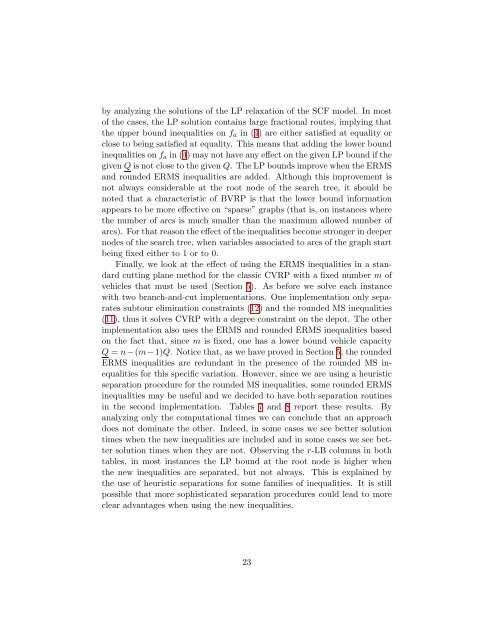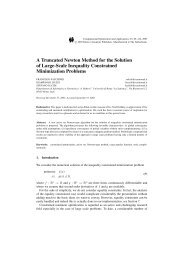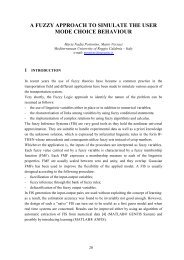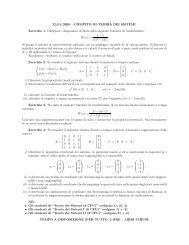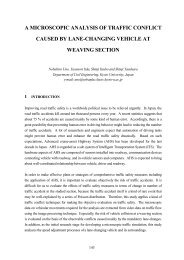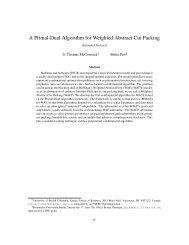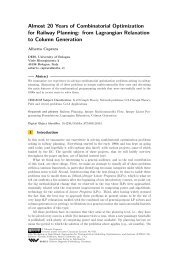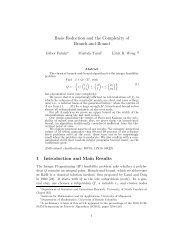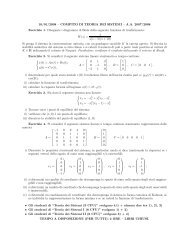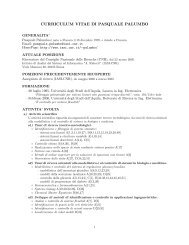Reverse Multistar Inequalities and Vehicle Routing ... - IASI-CNR
Reverse Multistar Inequalities and Vehicle Routing ... - IASI-CNR
Reverse Multistar Inequalities and Vehicle Routing ... - IASI-CNR
Create successful ePaper yourself
Turn your PDF publications into a flip-book with our unique Google optimized e-Paper software.
y analyzing the solutions of the LP relaxation of the SCF model. In most<br />
of the cases, the LP solution contains large fractional routes, implying that<br />
the upper bound inequalities on fa in (4) are either satisfied at equality or<br />
close to being satisfied at equality. This means that adding the lower bound<br />
inequalities on fa in (4) may not have any effect on the given LP bound if the<br />
given Q is not close to the given Q. The LP bounds improve when the ERMS<br />
<strong>and</strong> rounded ERMS inequalities are added. Although this improvement is<br />
not always considerable at the root node of the search tree, it should be<br />
noted that a characteristic of BVRP is that the lower bound information<br />
appears to be more effective on “sparse” graphs (that is, on instances where<br />
the number of arcs is much smaller than the maximum allowed number of<br />
arcs). For that reason the effect of the inequalities become stronger in deeper<br />
nodes of the search tree, when variables associated to arcs of the graph start<br />
being fixed either to 1 or to 0.<br />
Finally, we look at the effect of using the ERMS inequalities in a st<strong>and</strong>ard<br />
cutting plane method for the classic CVRP with a fixed number m of<br />
vehicles that must be used (Section 5). As before we solve each instance<br />
with two branch-<strong>and</strong>-cut implementations. One implementation only separates<br />
subtour elimination constraints (12) <strong>and</strong> the rounded MS inequalities<br />
(11), thus it solves CVRP with a degree constraint on the depot. The other<br />
implementation also uses the ERMS <strong>and</strong> rounded ERMS inequalities based<br />
on the fact that, since m is fixed, one has a lower bound vehicle capacity<br />
Q = n − (m − 1)Q. Notice that, as we have proved in Section 5, the rounded<br />
ERMS inequalities are redundant in the presence of the rounded MS inequalities<br />
for this specific variation. However, since we are using a heuristic<br />
separation procedure for the rounded MS inequalities, some rounded ERMS<br />
inequalities may be useful <strong>and</strong> we decided to have both separation routines<br />
in the second implementation. Tables 7 <strong>and</strong> 8 report these results. By<br />
analyzing only the computational times we can conclude that an approach<br />
does not dominate the other. Indeed, in some cases we see better solution<br />
times when the new inequalities are included <strong>and</strong> in some cases we see better<br />
solution times when they are not. Observing the r-LB columns in both<br />
tables, in most instances the LP bound at the root node is higher when<br />
the new inequalities are separated, but not always. This is explained by<br />
the use of heuristic separations for some families of inequalities. It is still<br />
possible that more sophisticated separation procedures could lead to more<br />
clear advantages when using the new inequalities.<br />
23


